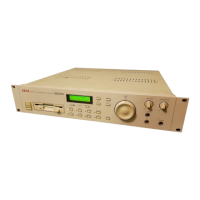APPENDIX 1
Page 214 S2000 Operator’s Manual - Version 1.30
CONNECTING AN EXTERNAL HARD DISK DRIVE
SCSI devices (hard disk drives, CD-ROMs, etc.) are connected as follows:
SCSI INTERFACE HARD DISK DRIVE
(or CD ROM, etc.)
To other SCSI devices
SCSI CABLE
The S2000 uses a 25-pin SCSI connector. Using a suitable SCSI cable
7
, connect the drive(s)
to the S2000 as shown above. Most drives have two SCSI connections and the other can be
used as a ‘thru’ to other SCSI devices such as CD ROM or another hard disk drive, etc..
NOTES ON USING HARD DISK DRIVES
SCSI CABLES
Always use high quality SCSI cables. Using cheaper SCSI cables may seem an attractive
proposition, especially if you have a tight budget but low quality cables can give rise to data
errors.
The SCSI connection requires that every connection is individually grounded. There are two
main types of SCSI cable you can buy. One is the ‘moulded’ type with moulded connectors
either end and a round cable. The other type are flat ‘ribbon’ cables. This type of cable is really
intended only for use inside devices.
Some moulded cables only have a single ground for all the connections and so can be
unreliable. They are probably fine when used with a computer for loading small documents
such as word processor files, etc., but with the large amounts of sample data used on the
S2000, we have had reports of them causing problems.
The flat ribbon cables, however, have individual grounding for each connection and so are
generally more reliable but, because they are intended for use inside devices (where they are
separately screened), they sometimes have insufficient screening which may cause data
noises to appear in your audio signal path when any disk activity is going on, especially if your
audio connections run parallel with the SCSI lead. However, if this is not a problem for you (and
in a studio it may not be), these cables are usually very good and usually perform much more
reliably. In a live situation, however, they are probably not ideal.
TERMINATION
A chain of SCSI devices must be terminated at either end and terminating resistors are fitted to
most SCSI devices when you buy them. The S2000’s SCSI interface is terminated. It is most
likely that the S2000 will be at one end of the chain and so must be left terminated. Any disks in
between the S2000 and the last SCSI device in the chain must be un-terminated (this can be
done by physically removing the resistors or sometimes via a DIP switch on the back of the unit
- please check the unit’s documentation). The last device in the chain must be terminated.
7 Some SCSI devices use 50-way connectors. If you are using such a SCSI device, you will need to have
a 25-pin to 50-way cable or you will need to buy a 50-way to 25-pin converter socket. Your dealer will be
able to help you with this.

